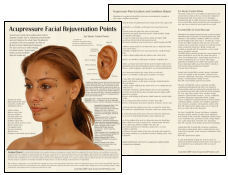Acupuncture & TCM Articles

Articles by Mary Elizabeth Wakefield, LAc, Dipl. Ac., MS, MM
Mary Elizabeth Wakefield has 27 years of clinical professional experience as a healing practitioner, and is a licensed acupuncturist, certified by the NCCAOM, a Zen Shiatsu practitioner, massage therapist, a cranio-sacral therapist, Acutonics® practitioner, opera singer, herbalist and Interfaith minister.
She is a graduate of Tri-State College of Acupuncture in New York City, and has studied with such notable acupuncturists as Carolyn Bengston, Kiiko Matsumoto, Dr. Mark Seem, Arya Nielson, Jeffrey Yuen, Dr. Richard Tan, Fabien Maman, Yitian Ni and Donna Carey.
Her knowledge of facial acupuncture and acupressure is based on the work of Jacques Lavier, the "Father of French Acupuncture." She has also studied extensively with her teacher Carolyn Bengston, who is a master of interdermal needling for the face.
For more information about Ms. Wakefield's Constitutional Facial Acupuncture Renewal™ seminars, please visit her website at www.chiakra.com
The Yang and Yin of Facial Acupuncture, Part One
By Mary Elizabeth Wakefield, LAc, Dipl. Ac., MS, MM and Belinda Anderson, PhD, MAOM, LicAc
This article is the first of a series in which we will explore the biomedical mechanisms involved in facial acupuncture, as well as the view of skin aging from the standpoint of Oriental medicine.
Our intention is to investigate, inform and, ultimately, synergize both approaches while honoring their diverse and unique voices.
The Western Approach: The Key to Success Lies in the Details
Western medicine and Chinese medicine might appear to advocate entirely different approaches to reality, but it might be more instructive for us to regard them as viewing the universe through different lenses. The former focuses the aperture of the camera to have a concentrated view of illness, seeing each cell as separate, specializing and compartmentalizing - zooming in close, seeking greater truths in the most minute findings and discoveries. It is a rational, logical endeavor that utilizes precise measurements which are linear and based upon "fact," documenting the results obtained in double-blind studies and clinical trials. We could say the Western legacy stems from a technological, intellectual query that defines progress in terms of a straight line.
Chinese Medicine: Seeing the Big Picture - Art or Science?

Oriental medicine bears some of the trappings of a science, but it's characterized by a conscientious observation of the cycles of creation, a perspective that has evolved over millennia. Its approach to an understanding of malaise might best be described as "wide-angle" in its intention, and it strives for solutions through reharmonizing the individual with the entirety of nature in its unceasing ebb and flow.
The assessment of harmony and disharmony that is Oriental medicine's point of departure is anything but linear, but rather more inclusive of intuition, invol-ving an almost artistic sensibility. This expanded perspective "opens the lens" to its maximum extent, acknowledging that, in contrast to the Western paradigm, the totality of a person is anything but the "sum of the parts," but rather a reflection of an infinitely greater unity. The practitioner involves themselves in a creative process that retunes the physical, emotional and psychospiritual landscape of the patient by recognizing that each person has his or her own particular timbre.
The Needle and the Microscope: A Dynamic Duo
Each of these disciplines has its intrinsic virtues. When "marinated" together with patience, understanding and respect, while acknowledging the individual contributions and strengths of each, an astonishing collaboration can occur. This is what we will attempt to convey in this series of articles, as we explore the workings of constitutional facial acupuncture renewal from these twin vantage points. We will perform a sacred marriage of these seeming opposites, stirring the pot au feu of yang and yin, opening and closing our camera lens as we deem appropriate, in order to more completely illuminate the nature of this innovative and yet ancient modality.
Getting "Under the Skin" of Facial Acupuncture: The Biomedical Model
Facial acupuncture is an increasingly popular choice for improving the appearance of the face. The scientific basis of facial acupuncture largely is unknown, with very little research having been undertaken. However, there are several widely practiced beauty treatments that lack a scientific basis, including non-ablative laser resurfacing (NLite; also called photorejuvenation) and intense pulsed light (IPL) therapy.
Despite little understanding of the scientific mechanism of exactly how acupuncture can regenerate the face, there is a significant and growing body of scientific literature describing many molecular and physiological effects of acupuncture, which are very relevant to understanding the effects of facial acupuncture.
Structure of the Skin
The skin consists of two main layers, the epidermis and dermis, and appendageal structures related to the hair and nails. The epidermis is the top layer of the skin and has up to five identifiable layers, representing different stages of cell maturation. Epidermal cells start to divide on the basal cell layer (the bottom layer). As they mature, they move up through the layers, producing the protein keratin, and eventually disintegrate, leaving a layer of keratin held together and waterproofed by lipid (fat) molecules. This layer of keratin gives skin its tough, resilient properties. Dead skin cells are constantly being shed from the surface of the skin. It takes approximately 35 days from the beginning of cell division to cell shedding. Abrasion of the skin surface can accelerate this process.
The dermis is the bottom layer under the epidermis. Its main function is to provide physical and nutritional support to the epidermis. The dermis consists of bundles of the protein collagen (and to a lesser extent, elastin), blood vessels, lymphatics, nerves, muscle fibers, mast cells, tissue macrophages, hair follicles, and sweat and sebaceous glands. Cells in the dermis (primarily the fibroblasts) produce the extracellular matrix (ECM), a structural scaffold providing support for the skin. The ECM consists of 90 percent collagen, with elastin comprising most of the remaining 10 percent. The collagen provides the tensile strength of skin, while the elastin gives the skin its elasticity. Unlike the epidermis, the dermis does not continually shed and regenerate itself. Collagen and elastin proteins have long half-lives and are turned over very slowly. Wounding of the skin can cause a transient regeneration of this dermis.
Functions of the Skin
The functions of the skin are as follows:
Protection. The skin provides protection against microbial entry, chemical hazards and mechanical trauma; helps prevent dehydration from loss of body fluids; and protects us from unwanted entry of fluids from the external environment. The pigment melanin, produced by specialized cells in the epidermis, protects against the harmful effects of overexposure to ultraviolet light.
Sensation. Millions of sensory receptors are located in the dermis, allowing the skin to serve as a sense organ, processing sensory information such as pressure, touch, temperature, pain and vibration.
Movement without injury. The skin's supple and elastic characteristics allow the body to grow and move without associated tearing and laceration.
Excretion. Skin regulates the volume and content of sweat, which influences the total fluid volume and waste product content of the body.
Vitamin D production. When the skin is exposed to ultraviolet light, skin cells produce the precursor of vitamin D, which is transported to the liver and kidneys, and then converted to vitamin D.
Immunity. Specialized cells that attach to and destroy pathogenic microorganisms are present in the skin. They play an important role in the body's immunity.
Homeostasis of body temperature. Skin plays a critical role in maintaining a relatively constant core body temperature despite widely varying environmental temperatures. The sweat glands and blood vessels in skin perform this function.
The Skin Is the Third Lung: An Oriental Medicine Perspective
In Oriental medicine, the lung corresponds to the Metal element and rules the skin; in Five-Element theory, the Metal season is considered to be autumn, which is dry and has adverse effects upon the skin. Being the uppermost organ, the lung is fragile and is referred to as "the canopy" of the zang fu or the "tender organ" because it's susceptible to invasion by external pernicious influences (EPIs), such as wind, cold, heat, damp, etc. Since the lung has dominion over the skin, we draw certain parallels to the biomedical model, noting that there also are crucial differences due to the comprehensive mechanism of the lung itself.
Protection. Wei qi or "defensive" qi provides a similar kind of protection as that associated with the function of the skin in Western medicine. From Chapter 43 of Simple Questions:
Defensive qi is derived from the coarse part of food and water; it is slippery in nature, hence it cannot enter the channels. It therefore circulates under the skin, in between the muscles. It vaporizes in between the membranes and diffuses over the chest and abdomen.
The main function of wei qi is to protect the body from climatic changes such as wind, cold, heat and damp. It protects us from the heat of the ultraviolet rays of the sun, from unwanted fluids or damp entering the body, from wind invading the channels, spasms, or cold invading our system.
Regulation. Wei qi warms and moistens the skin, maintains body temperature, and opens the pores. From Chapter 47 of The Spiritual Axis:
Defensive qi warms the muscles, fills up the skin, enters the spaces between the skin and the muscles, and opens the pores.
Therefore, by opening and closing the pores, the lung qi regulates perspiration and, by extension, body temperature, which helps prevent dehydration.
Immunity. Weak lung qi gives rise to weak wei qi and an impaired immune system; as the lung is the "tender" organ, any climatic changes can cause imbalances, such as a cold, flu, etc.
Excretion. The lung dominates the water passages.
The lung promotes and maintains water metabolism by the circulation and excretion of water, "which depends upon its natural descending function." In the Oriental medical system, it also controls respiration and qi, plus the hair (as well as the skin), and opens to the nose, among other functions.
Conclusion
As we hope is apparent from the above, this double-barreled approach to the modality of facial acupuncture already has elicited interesting correspondences between our two systems, although each has its own particular personality, quality of information and relevance. In the second part of this column, we will train our multipurpose camera on processes of skin aging, inflammatory response, hormones and photo-aging.
|
